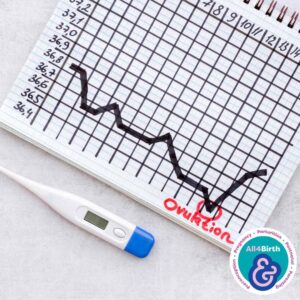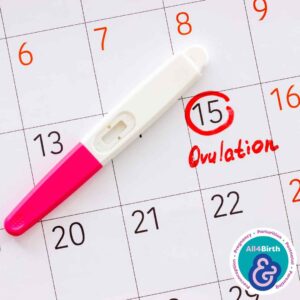Abbie Tomson
Midwife BSc MSc, Yoga Teacher, All4Birth Lead
@enevlorel
Summary
The menstrual cycle is a natural process in women of reproductive age. A complex interplay of hormones regulates it and involves the shedding of the uterine lining through vaginal bleeding. The cycle typically lasts between 21 to 35 days and can vary in length and intensity from person to person. The menstrual cycle has four phases: the menstrual phase, the follicular phase, the ovulatory phase, and the luteal phase. Each phase is characterised by different hormonal changes and physical symptoms. Understanding the menstrual cycle can help women track their fertility and identify potential issues or irregularities. This freeflow article will cover the follicular phase, characterised by the growth and development of follicles in the ovaries.
What is ‘the follicular phase’? 1
The follicular phase is the second phase of the menstrual cycle, characterised by the growth and development of follicles in the ovaries. These follicles contain immature eggs that will eventually be released during ovulation. The follicular phase typically lasts 10 to 14 days, although it can vary from person to person. During this phase, the pituitary gland releases follicle-stimulating hormone (FSH), which stimulates the growth of follicles in the ovaries. As the follicles grow and mature, they produce and release oestrogen. As oestrogen levels rise, they help thicken the uterine lining in preparation for a pregnancy. The rise in oestrogen also triggers a surge of luteinising hormone (LH), which stimulates the release of a mature egg from one of the follicles. Ovulation marks the end of the follicular phase and the start of the ovulatory phase. The follicular phase is an important phase of the menstrual cycle because it sets the stage for ovulation and, ultimately, pregnancy. Any disruptions in the hormonal balance during this phase can lead to irregularities in the menstrual cycle or difficulty conceiving.
What is typically ‘normal’ in the follicular phase? 1
Although everybody’s ‘normal’ will differ, it’s important to understand the general underlying physiology of this phase. A normal follicular stage of the menstrual cycle typically lasts 10 to 14 days, although it can vary slightly from person to person. A normal follicular stage is characterised by regular cycles with consistent length and timing. Women generally have a good sense of what is normal for their bodies. Any significant changes to the length or intensity of bleeding or the regularity of periods may warrant medical attention, as they may be indicative of a hormonal imbalance or other underlying condition. It is important to note that while a normal follicular stage is an important part of the menstrual cycle, it does not guarantee fertility.
Symptoms that may prompt investigation into your follicular phase
Several signs and symptoms can characterise an abnormal follicular phase of the menstrual cycle. Some of the common signs of an abnormal follicular phase include:
1. Irregular periods: If the length of the menstrual cycle varies significantly from month to month or if periods are missed altogether, it may indicate an underlying hormonal imbalance or other medical condition affecting the follicular phase. 2
2. Short follicular phase: If the follicular phase is consistently shorter than ten days, it may indicate a problem with follicle development or hormonal imbalances. 3
3. Long follicular phase: If the follicular phase is consistently longer than 14 days or varies significantly from month to month, it may indicate a problem with follicle development or hormonal imbalances. 3
4. Failure to ovulate: If ovulation does not occur during the follicular phase, it may indicate an underlying medical condition such as polycystic ovary syndrome (PCOS).
5. Abnormal cervical mucus: If it is absent, scanty, or does not change in consistency during the follicular phase, it may indicate an underlying medical condition. 4
If any of these signs or symptoms are experienced, it is important to consult a healthcare provider for further evaluation and treatment. Any disruptions in the hormonal balance during the follicular phase can lead to an irregular menstrual cycle or difficulty conceiving.
Why is an understanding of the follicular phase important when trying to conceive?
Understanding the follicular phase of the menstrual cycle is important when trying to conceive because it is the period leading up to ovulation, which is the optimal time for conception. By tracking the length of their menstrual cycle and the timing of their periods, people can estimate when ovulation is likely to occur and plan intercourse accordingly. This is important because fertilisation can only occur when sperm are present in the female reproductive tract at the time of ovulation. Additionally, understanding the follicular phase can help women identify any potential issues or irregularities that may affect their fertility. For example, irregular periods or absent periods can indicate hormonal imbalances that may make it more difficult to conceive. In such cases, seeking medical advice can help identify any underlying issues and improve the chances of successful conception. Overall, understanding the follicular phase is an important step in optimizing fertility and increasing the chances of successful conception.
Links to other resources
 Articles
Articles
Periods and Fertility in the Menstrual Cycle | NHS
Menstrual Cycle and Getting Pregnant | Tommy’s
 Books
Books
It Starts with an Egg | Rebecca Fett
Taking Charge of Your Fertility | Toni Weschler
 Film Audio
Film Audio
 Websites
Websites
References.
- Weschler, T. (2016). Taking Charge of Your Fertility: The Definitive Guide to Natural Birth Control, Pregnancy Achievement, and Reproductive Health. Random House
- Munro MG, Critchley HO, Fraser IS; FIGO Menstrual Disorders Committee. The two FIGO systems for normal and abnormal uterine bleeding symptoms and classification of causes of abnormal uterine bleeding in the reproductive years: 2018 revisions. International Journal of Gynecology & Obstetrics. 2018;143(3):393-408.
- Xie, Q., Suo, L., & Kuang, Y. (2020). Impact of follicular phase length on pregnancy outcomes: the longer, the better?. Reproductive biomedicine online, 41(2), 350. https://doi.org/10.1016/j.rbmo.2020.04.023
- Najmabadi, S., Schliep, K. C., Simonsen, S. E., Porucznik, C. A., Egger, M. J., & Stanford, J. B. (2021). Cervical mucus patterns and the fertile window in women without known subfertility: a pooled analysis of three cohorts. Human reproduction (Oxford, England), 36(7), 1784–1795. https://doi.org/10.1093/humrep/deab049










